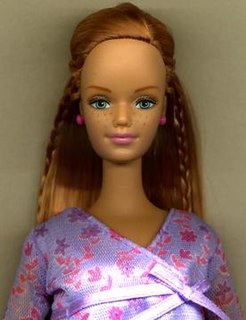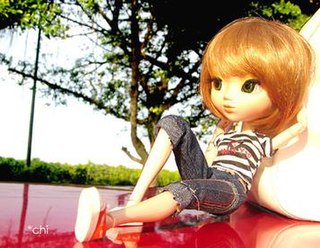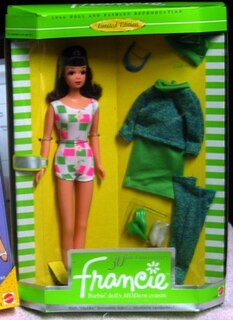Related Research Articles

The Himalayan, is a breed or sub-breed of long-haired cat similar in type to the Persian, with the exception of its blue eyes and its point colouration, which were derived from crossing the Persian with the Siamese. Some registries may classify the Himalayan as a long-haired sub-breed of Siamese, or a colorpoint sub-breed of Persian. The World Cat Federation has merged them with the Colorpoint Shorthair and Javanese into a single breed, the Colorpoint.

Midge Hadley is a fictional doll character in the Barbie line of toys by Mattel that was first released in 1963. Midge was created, along with Skipper, to counteract criticism that claimed Barbie was a sex symbol. She was marketed as Barbie's best friend. No Midge dolls were sold for the rest of the vintage years after the 1960s.

A Darumadoll is a hollow, round, Japanese traditional doll modeled after Bodhidharma, the founder of the Zen tradition of Buddhism. These dolls, though typically red and depicting a bearded man (Bodhidharma), vary greatly in color and design depending on region and artist. Though considered a toy by some, Daruma has a design that is rich in symbolism and is regarded more as a talisman of good luck to the Japanese. Daruma dolls are seen as a symbol of perseverance and good luck, making them a popular gift of encouragement. The doll has also been commercialized by many Buddhist temples to use alongside the setting of goals.

Blythe is a fashion doll, about 28 cm (11 inch) tall, with an oversized head and large eyes that change color with the pull of a string. It was created in 1972 and was initially only sold for one year in the United States by toy company Kenner. In 2001 the Japanese toy company Takara began producing new editions of Blythe dolls. There is a network of hobbyists who customize the doll for resale and create clothing and shoes for Blythe. Enthusiasts share photographs of their work and other types of dolls on the Internet.
Rainbow Brite, also known in Japan as Magical Girl Rainbow Brite, is a media franchise by Hallmark Cards, introduced in 1983. The animated Rainbow Brite television series first aired in 1984, the same year Hallmark licensed Rainbow Brite to Mattel for a range of dolls and other merchandise. A theatrical feature-length film, Rainbow Brite and the Star Stealer, was released by Warner Bros. in 1985. The franchise was rebooted in 2014 with a three part mini-series released on Hallmark's online streaming video service, Feeln. A line of new merchandise by Hallmark online and in its shops debuted in 2015.

Pullip is a fashion doll created by Cheonsang Cheonha of South Korea in 2003. Pullip has a jointed plastic body and a relatively oversized head, with eyes that can move from side to side and eyelids that can blink. Pullip was first marketed by Jun Planning out of Japan; but the company underwent management changes in early 2009 and, since then, has operated out of South Korea under the name Groove. Since the release of the original female doll, other companion dolls have been added: male dolls Namu and Taeyang ; Taeyang's younger sister, Dal ; Dal's best friend, Byul ; and Pullip's younger brother, Isul. In February 2013, a new member of the Pullip family was introduced, called Yeolume, who is Pullip's future daughter. There is also a miniature line called Little Pullip, with 1:12 scale bodies and 1:6 scale heads. Pullip and her counterpart dolls are often customized by collectors, with the most common customizations including wig changes, eye color changes, and rebodying.
Chatty Cathy was a pull string "talking" doll manufactured by the Mattel toy company from 1959 to 1965. The doll was first released in stores and appeared in television commercials beginning in 1960, with a suggested retail price of $18.00, but catalog advertisements usually priced the doll under $10.00. Chatty Cathy was on the market for six years and was the second most popular doll of the 1960s after Barbie.

Gyaru (ギャル) is a Japanese transliteration of the English slang word 'gal' ("girl") used to define a fashion subculture in Japan. It is rumored to be inspired by the popular late 1980s American action drama series Baywatch, that also appeared on Japanese television. The fashion style was probably created and then popularized by Pamela Anderson's role in the show at the time. It is rumored that gyaru was an exaggeration and over-representation of American teenage party culture in Japan. The term's usage peaked in the early 2000s, and has since gradually declined. This decline has been referred to as a strategy of the magazine organizations, over-exaggeration of the fashion, western media or even government policies. The meaning of the term gyaru gradually drifted to apply to a slightly older demographic whose apparent lack of interest in work or marriage resulted in these women being regarded as childish or a "hussy". Due to its past and its present connotation, it is now used almost interchangeably with kogal.
Dollikins were dolls manufactured by Uneeda Doll Company, a company founded in 1917 in Brooklyn, New York. The dolls started at 19-20" tall, although later versions were 12" and 6". The dolls were manufactured from about 1957 to 1962 to compete with similar 18–21 inch sized dolls, that were popular through the 1950s and 1960s, such as Madame Alexander's "Cissy", Ideal's "Revlon", American Character's "Toni", Deluxe Reading's "Candy" Horseman's "Sindy". Horseman's "Wonderkin" and Valentine's "Mannikin"

What's Her Face was a line of customizable dolls that straddled the line between traditional fashion dolls and creative activity toys. Made by Mattel, the line ran from 2001–2003, and enjoyed only a modest success in a market dominated by Mattel's iconic Barbie and MGA Entertainment's Bratz dolls. Following the discontinuation of the What's Her Face line, their body molds were used for the Wee 3 Friends line of Barbie-related dolls. Several fashion, wig, and activity packs were also released for the What's Her Face line.
Diva Starz was a series of fashion dolls created and released by Mattel in the fall of 2000. They are similar in design to the MGA Entertainment Bratz dolls released in 2001, and the Flavas dolls released by Mattel in 2003. Original four dolls, Alexa, Nikki, Summer, and Tia were offered in the original debut. The line was discontinued in 2004.

Francie Fairchild is a fashion doll issued by Mattel from 1966 to 1976 and re-introduced in 2011. Marketed as "Barbie's MODern cousin" from England, the doll had an extensive line of "mod"-style clothing, often employing bright colors and geometric patterns similar to fashions associated with Carnaby Street in the late 1960s to early 1970s. At 11¼ inches tall, the Francie doll was shorter than Barbie, but taller than Skipper, making the character presumably between the two in age.

My Child dolls are a toy made by Mattel from 1985-1988. Most had felt "skin" on their heads although some had vinyl skin.
Kiddles were dolls originally produced by toymakers Mattel Inc. in 1965. They were introduced at the 1966 New York Toy Fair and put on the market soon after. Initially about 3 inches tall, they were tiny by doll standards. The sensation they created in the toy world caused other toy companies to produce their own tiny dolls.

A reborn doll is an art doll created from a manufactured doll or kit that has been transformed by an artist to resemble a human infant with as much realism as possible. The process of creating a reborn doll is referred to as reborning and the doll artists are referred to as reborners. Reborn dolls are also known as lifelike dolls or reborn baby dolls.

The Sonny & Cher dolls were a collection of 12-¼ inch high celebrity doll likenesses of pop rock duo Sonny & Cher. The line was released by Mego Corporation in 1976. The release of these fashion dolls coincided with the popularity of The Sonny & Cher Show prime time variety TV show.

A bisque doll or porcelain doll is a doll made partially or wholly out of bisque or biscuit porcelain. Bisque dolls are characterized by their realistic, skin-like matte finish. They had their peak of popularity between 1860 and 1900 with French and German dolls. Bisque dolls are collectible, and antique dolls can be worth thousands of dollars. Antique German and French bisque dolls from the 19th century were often made as children's playthings, but contemporary bisque dolls are predominantly made directly for the collectors market.

Titian is a tint of red hair, most commonly described as brownish-orange in color. It is often confused with Venetian and auburn.
References
| This doll-related article is a stub. You can help Wikipedia by expanding it. |